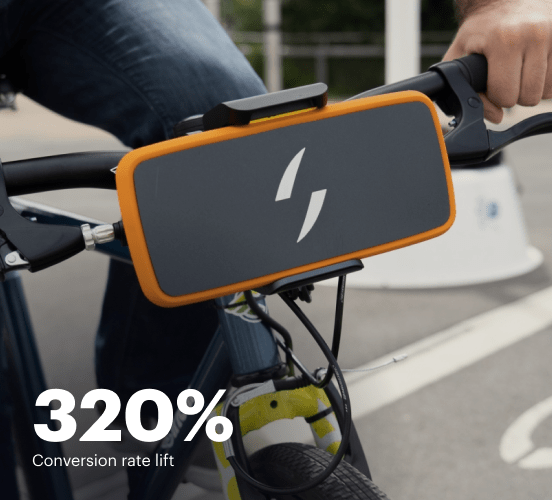Pardot vs. WordPress: the best platform for a seamless web experience
Discover how Pardot compares to WordPress regarding features and usability. Find out which platform provides the competitive advantage your business deserves.
Get startedSee how Instapage stacks up against the competition
| Feature | Instapage | Other builders |
| Drag-and-Drop Tools | ||
| Conversion-optimized templates | ||
| Manual and AI-powered A/B Tests | ||
| AI content suggestions | ||
| Popups and sticky bars | ||
| Canvas and grid blocks | ||
| Reusable and global elements | ||
| Form and popup builders | ||
| Built-in Heatmaps | ||
| Central analytics dashboard | ||
| Ad-to-page personalization and collections | ||
| Contacts, lists, and email | ||
| Dedicated, full-service CRO experts | ||
| Enterprise-ready platform |
Leading the way in building high-performing landing pages





Why Instapage is the smarter choice for your campaigns
Get everything you need to build, scale, and optimize high-converting landing pages—without coding.

Easier page building without coding
Instapage offers a flexible and seamless page creation experience with a library of 500+ conversion-focused layouts, Instablocks®, a drag-and-drop builder, and AI content generation. With technologies like Thor Render Engine®, you can create on-brand, mobile-responsive landing pages that load quickly and start converting during initial visitor clicks.

More insights — better results
Instapage lets you see in detail how each landing page experience and variation is performing so you can make targeted changes that boost page conversions. Use heatmaps for a better understanding of on-page activities, run A/B tests and AI-assisted experiments, and then track and evaluate results within robust analytics dashboards.

More personalized experiences
Instapage lets you quickly create high-performing landing pages tailored to each of your ad campaigns. Deliver personalized experiences for distinct audiences using dynamic text replacement. Effortlessly align specific advertisements to unique pages with AdMaps. Monitor audience-level metrics using our advanced data tools.

Built-in collaboration
Instapage collaboration capabilities bring your entire team together to speed up the process of landing page review, approval, and launch. No more frustrating and unnecessary revisions or edits scattered across emails. Provide instant feedback, conduct real-time page edits, and securely share your pages with outside stakeholders.

Free up time for your business
Invest time into business growth, not busy work. Launch landing pages faster with reusable forms and templates. Build once, reuse forever.
Explore all integrations






Easier page building without coding
Instapage offers a flexible and seamless page creation experience with a library of 500+ conversion-focused layouts, Instablocks®, a drag-and-drop builder, and AI content generation. With technologies like Thor Render Engine®, you can create on-brand, mobile-responsive landing pages that load quickly and start converting during initial visitor clicks.
More insights — better results
Instapage lets you see in detail how each landing page experience and variation is performing so you can make targeted changes that boost page conversions. Use heatmaps for a better understanding of on-page activities, run A/B tests and AI-assisted experiments, and then track and evaluate results within robust analytics dashboards.
More personalized experiences
Instapage lets you quickly create high-performing landing pages tailored to each of your ad campaigns. Deliver personalized experiences for distinct audiences using dynamic text replacement. Effortlessly align specific advertisements to unique pages with AdMaps. Monitor audience-level metrics using our advanced data tools.
Built-in collaboration
Instapage collaboration capabilities bring your entire team together to speed up the process of landing page review, approval, and launch. No more frustrating and unnecessary revisions or edits scattered across emails. Provide instant feedback, conduct real-time page edits, and securely share your pages with outside stakeholders.
Free up time for your business
Invest time into business growth, not busy work. Launch landing pages faster with reusable forms and templates. Build once, reuse forever.
Explore all integrationsGet started with Instapage in a few steps
-
Create your Instapage account
Start with Instapage by signing up via Google or your email. You'll get access to a free 14-day trial to discover Instapage capabilities. Feel free to cancel anytime during the 14-day trial if you decide that our product is not suitable for your business. -
Build and personalize your page
Create your first landing page from scratch or choose a template from 500+ customizable layouts. Use the drag-and-drop builder to add page elements, fonts, and backgrounds, refine content with AI, or add custom HTML, Javascript, and CSS. -
Review and make edits
Collaborate on page designs and streamline review processes. Invite your team members and stakeholders to review, edit, and provide feedback on your landing page. Collaborate knowing your page is confidential and only accessible to authorized users. -
Publish and track page performance
Publish your page to a domain or custom URL. Connect your pages to the ads you've created and track page performance within the analytics dashboard, run A/B tests and AI experiments, analyze results, and continuously optimize your landing page to maintain high conversions.
Pardot vs. WordPress: The Epic Rivalry with a Twist
In the bustling realm of digital marketing, choosing the right platform can feel like being tossed into a high-stakes game show. With myriad options at your fingertips, deciding between two prominent players, Pardot and WordPress, can seem overwhelming. Both platforms serve distinct purposes and target different aspects of a marketer's strategy. Pardot, designed primarily for B2B marketing automation, streamlines lead generation and nurturing processes. Meanwhile, WordPress offers unmatched versatility as a content management system that allows anyone to craft a website or blog with ease. As we dive deeper into this comparison, it'll become clear that while these two are formidable contenders, there's another player lurking in the shadows: Instapage, a true specialist in landing pages and conversion optimization. The following sections will dissect each platform's attributes, usability, performance metrics, pricing strategies, and conclude with a glance at what Instapage brings to the table.
Introducing the Titans of Digital Marketing
Let’s take a closer look at these juggernauts. Pardot, a Salesforce product, is like a skilled archer, focused on precision and target practice. With its robust lead scoring and nurturing features, it ensures that businesses can maintain relationships with potential clients effectively. On the other hand, WordPress stands tall as a fortress in the digital landscape—its flexibility and extensive plugin ecosystem allow users to create any type of site, from blogs to e-commerce platforms. As we prepare to contrast their key components, keep in mind the stakes are high. Each platform possesses unique strengths that appeal to different segments of users, making them leaders in their respective areas. Furthermore, Instapage charges onto the scene as a fast and nimble contender, especially when it comes to crafting high-converting landing pages, offering an approach that's different yet complementary to both Pardot and WordPress. With this in mind, let's kick off the first round.
Round 1: Feature Face-Off
In the digital arena, features are akin to a fighter's arsenal. Pardot shines with its streamlined marketing automation tools—offering predictive lead scoring, customizable email campaigns, and comprehensive analytics. It’s a platform that speaks the language of B2B marketers wanting to enhance their sales funnel. Conversely, WordPress boasts a seemingly endless array of features facilitated by thousands of plugins. From SEO tools to analytics, it offers an adaptable framework suited for any marketer's needs. But just when you think it’s a settled duel, Instapage enters, equipped with specialized landing page designs, A/B testing tools, and integrations that enhance conversion rates. The real question is, which features matter most to your business goals?
Round 2: User-Friendly Showdown
Navigating Pardot and WordPress can sometimes feel like stepping onto different planets. Pardot caters to B2B professionals with a straightforward interface designed for users who may not be tech-savvy. However, it can feel a bit overwhelming for beginners. Conversely, WordPress is both a blessing and a curse—while its learning curve might seem daunting initially, exploring the depths of its customization can be an exhilarating experience for website creators. On a lighter note, whether picking a theme on WordPress or learning the ins and outs of Pardot’s automation features, one can consider it more of a learning adventure rather than a steep climb. Meanwhile, Instapage comes highly recommended for its intuitive drag-and-drop editor, making landing page creation seamless, regardless of your technical expertise.
Pardot's Key Features:
- Robust lead scoring and grading systems to prioritize prospects.
- Streamlined email marketing automation for targeted campaigns.
- Integration with Salesforce for comprehensive sales and marketing alignment.
- Detailed analytics for campaign performance tracking.
- Personalized landing pages for high-quality lead captures.
WordPress's Unique Features:
- Customizable themes and plugins for unique site design.
- Built-in SEO tools and optimization capabilities.
- Strong community support for troubleshooting and enhancements.
- An extensive library of educational resources and tutorials.
Common Strengths of Both Platforms:
- User-friendly interfaces that facilitate accessibility.
- Support for a wide range of integrations to enhance functionality.
- Responsive design capabilities to ensure mobile friendliness.
- Data tracking and analytics to measure success.
- Continuous updates and enhancements to features.
- Extensive documentation and user communities.
In this match-up, it’s clear that while both platforms have compelling strengths, Instapage stands out as a formidable competitor—especially for users focused specifically on landing page performance and optimization. As we transition to the next round, keep in mind how each platform serves B2B and B2C strategies differently.
Round 3: Performance Showdown
When putting Pardot and WordPress to the test, performance is critical, especially during peak traffic times. Slow-loading pages can be likened to trying to run through molasses—excruciatingly slow and frustrating. Pardot is efficient in this regard, with optimized features geared towards B2B conversions. On the flip side, WordPress's performance greatly hinges on the hosting service chosen; with the right hosting provider, it can achieve lightning-fast speeds. Both platforms offer responsive designs, ideal for catering to mobile users—a critical factor in today's digital landscape. However, as more marketers recognize the importance of speed, Instapage has positioned itself as a formidable choice with lightning-fast loading times and seamless mobile integration for landing pages that drive conversions.
Round 4: Customer Support Face-Off
Support systems are the backbone of any platform’s success. Pardot offers extensive customer service options, including phone support and detailed online resources. WordPress, being community-driven, features countless forums and community support groups, providing assistance for troubleshooting and guidance on best practices. In the world of marketing, having quick access to support feels like having a trusted sidekick ready with an encouraging nudge or timely advice. Instapage also excels in providing dedicated support channels and responsive assistance to help marketers navigate their unique needs effectively.
Round 5: Pricing Smackdown
Pardot Pricing Advantages:
- Tiered pricing that allows scalability as business needs grow.
- Access to a variety of powerful tools under one roof.
- Integration with Salesforce can streamline costs for existing users.
- Comprehensive features that justify the investment.
WordPress Pricing Advantages:
- Free access to the basic version, making it budget-friendly.
- Affordable premium themes and plugins to extend functionality.
- Flexible hosting options to suit diverse budgets.
- Ability to earn revenue through ads or affiliate marketing.
In this pricing showdown, both platforms present compelling arguments, yet Instapage emerges with a pricing model designed for high ROI and value. Its competitive pricing strategy and dedicated landing page tools could easily shift the advantage, making it a strategic choice for those focused on conversions.
As we explore the pricing structures of these platforms, it's essential to consider what aligns best with your specific objectives and budget. Remember, getting what you pay for sometimes means encountering unexpected value where you least anticipate it.
And Then We Have Instapage...
In the midst of this competition, Instapage reveals itself as the game-changer that brands often seek. As a landing page powerhouse, it simplifies complex processes into intuitive steps for users, ensuring high conversion rates through targeted page designs and robust analytics. While Pardot focuses on nurturing leads and WordPress serves as a flexible content hub, Instapage zeroes in on ensuring every visitor is a potential customer, guiding them seamlessly to conversions. It’s this unique positioning that makes Instapage a compelling option for businesses aiming to optimize their landing pages for maximum impact. The ability to streamline conversions with ease opens new doors for marketers that the other platforms might not fully match.
In conclusion, selecting the right platform for your marketing needs is crucial. With the insights gained from this comparison, consider how each option aligns with your business goals. Remember, the journey towards effective marketing can be exhilarating—one that allows you to reach new heights, especially with a partner like Instapage leading the charge. Dive deeper into its capabilities and discover just how it can elevate your marketing strategy.










